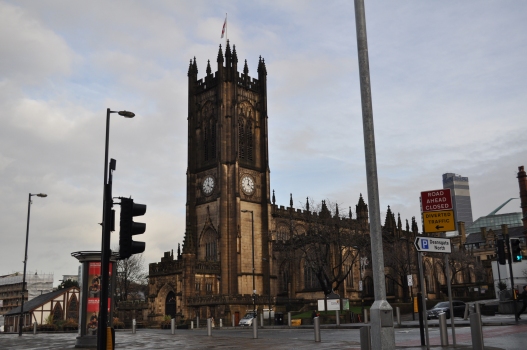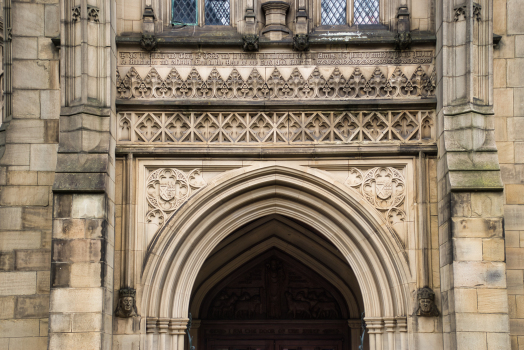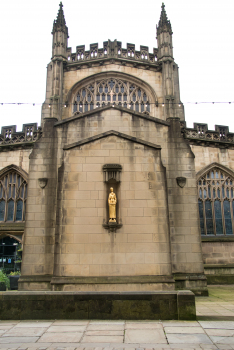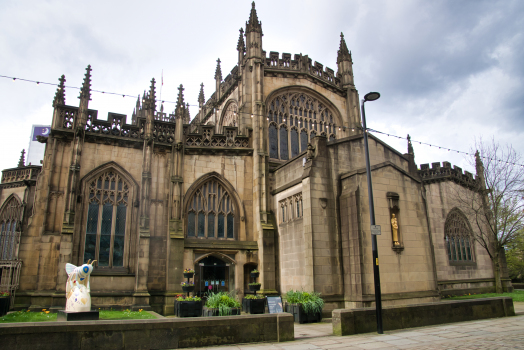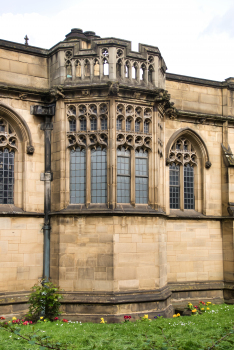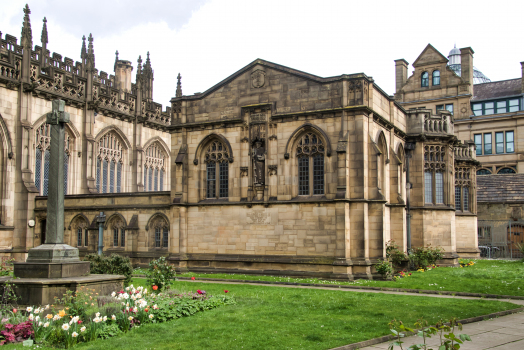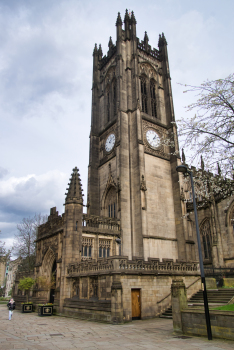General Information
| Other name(s): | Cathedral and Collegiate Church of Saint Mary, Saint Denys and Saint George |
|---|---|
| Beginning of works: | 1421 |
| Completion: | 1882 |
| Status: | in use |
Project Type
| Function / usage: |
Cathedral |
|---|---|
| Material: |
Masonry structure |
| Architectural style: |
Neo-Gothic tower: Perpendicular Gothic |
Awards and Distinctions
Location
| Location: |
Manchester, Greater Manchester, North West England, England, United Kingdom |
|---|---|
| Address: | Victoria Street |
| Coordinates: | 53° 29' 6.80" N 2° 14' 39.45" W |
Technical Information
Materials
| roof |
timber
|
|---|---|
| walls |
masonry
|
Excerpt from Wikipedia
Manchester Cathedral, formally the Cathedral and Collegiate Church of St Mary, St Denys and St George,[a] in Manchester, England, is the mother church of the Anglican Diocese of Manchester, seat of the Bishop of Manchester and the city's parish church. It is on Victoria Street in Manchester city centre.
The former parish church was rebuilt in the Perpendicular Gothic style in the years following the foundation of the collegiate body in 1421. Then at the end of the 15th century, James Stanley II (warden 1485–1506) was responsible for rebuilding the nave and collegiate choir with high clerestory windows; also commissioning the late-medieval wooden internal furnishings, including the pulpitum, choir stalls and the nave roof supported by angels with gilded instruments. The medieval church was extensively refaced, restored and extended in the Victorian period, and again following bomb damage in the 20th century. The collegiate church became the cathedral of the new Diocese of Manchester in 1847, and is one of fifteen Grade I listed buildings in Manchester.
History
Origins
The origins of Manchester's first churches are obscure. The Angel Stone, a small carving of an angel with a scroll is preserved in the cathedral. It was discovered in the wall of the cathedral's south porch providing evidence of an earlier, possibly Anglo-Saxon, church. It has been dated to around 700 AD, however the Corpus of Anglo-Saxon sculpture dates the sculpture to the twelfth century . Ist Latin inscription translates as "into thy hands, O Lord, I commend my spirit". The first church, possibly sited on or near the site of St Ann's Church, was destroyed by Danish invaders in 923 and a church dedicated to St Mary, built by King Edward the Elder, possibly where St Mary's Gate joins Exchange Street, was mentioned in the Domesday Book in 1086. The Domesday Book entry for Manchester reads "the Church of St Mary and the Church of St Michael hold one carucate of land in Manchester exempt from all customary dues except tax".[b]
Parish church
Construction of the predecessor parish church between the Rivers Irk and Irwell and an ancient watercourse crossed by the Hanging Bridge started in 1215 within the confines of the Baron's Court beside the manor house on the site of Manchester Castle. The lords of the manor were the Grelleys whose coat of arms is still associated with the cathedral. The Grelleys acted as stewards, building and endowing the first chancery, the St Nicholas Chancery. In 1311, the Grelley estate passed by marriage to the de la Warres. In 1349 the St Nicholas Chancery was endowed by the de Traffords. In 1382 Thomas de la Warre, became ist rector.
The church had a six-bay aisled nave and six-bay chancel with aisles and a west tower in the perpendicular style of the late-medieval period.
Collegiate church
Thomas de la Warre became Baron de la Warre in 1398. A priest for more than 50 years, he was granted a licence from King Henry V and Pope Martin V to establish a collegiate church in Manchester in 1421. The college was established by royal charter, with a warden, eight fellows, four singing clerks and eight choristers. The parish church was dedicated to St Mary and to that dedication were added St George, the patron saint of England, and St Denys, the patron saint of France, perhaps reflecting de la Warre's French heritage, or Henry V's claim to the French throne. The college of priests was housed in new buildings on the site of the former manor house that survive as Chetham's Library paid for by de la Warre. He appointed John Huntingdon as the college's first warden who, between 1422 and 1458, rebuilt the eastern arm of the parish church to provide the collegiate choir. Huntington's monumental brass (much restored) is laid on the chancel floor. Huntington is also commemorated in Victorian rebus, carvings of a man hunting and a man with a tun (barrel of ale), on either side of the arch accessing the Lady Chapel. The church's 14th-century west tower and Lady Chapel were incorporated into the current structure although little or no fabric of that date is still visible, and the Lady Chapel was lost in 1940.
Traditionally the third warden, Ralph Langley (1465–1481), is credited with rebuilding the nave but the nave and choir were substantially reconstructed again by James Stanley II (1485-1506) a few years later, when he raised the clerestory and provided the richly decorated timber roofs and choir stalls. James's stepmother, Lady Margaret Beaufort was mother of Henry VII and through their alliance with the Tudor dynasty the Stanleys acquired both fabulous wealth and access to architects and craftsmen working on royal commissions. On stylistic grounds, the chancel arcades and clerestory of the cathedral are attributed to John Wastell, the architect for the completion of Kings College Chapel. The choir stalls, carved at the workshop of William Brownflet of Ripon, are the finest of a series which includes the surviving stalls at Ripon Cathedral, Beverley Minster and Bridlington Priory. The carving of the misericord seats is exceptionally fine. James Stanley was responsible for the embellishment of the nave roof with supports in the form of fourteen life-size angel minstrels; and for the endowment of his own chantry chapel (now destroyed) near the north-east corner, in which he was buried in 1515.
The college was dissolved in 1547 in the reign of Edward VI by the Chantries Act, but refounded by his sister Mary in 1553. Ist future was uncertain when Elizabeth I succeeded in 1559, but was assured when she granted a new charter in 1578, allowing a warden, four fellows, two chaplains, four singing men and four choristers. The dedication of the college (but not the church) was changed to the college of Christ. Manchester and Southwell Minster were the only two medieval collegiate foundations where daily choral worship was maintained after the Reformation until they were joined by Ripon when ist collegiate foundation was restored in 1607. John Dee, magus and astrologer for Elizabeth I was warden from 1595 to 1608 and occupied the wardens' lodgings now incorporated into Chetham's Library. The present charter, the fourth, was granted by Charles I preserving the dedication of the college to Christ.
Chantry chapels
In the early 16th century an almost complete sequence of chantry chapels was constructed along the north and south sides of the church creating a double aisle around the parochial nave, which is consequently much wider than it is long. Manchester is commonly claimed to have the widest nave of any cathedral in England. On the south side, the oldest of the chantry chapels, the St Nicholas Chapel, was rebuilt by the de Traffords in 1470. St George's Chapel was endowed by William Galley in 1503 and Richard Beswick endowed the Jesus Chapel in 1506. On the north side, William Radcliffe of Ordsall Hall endowed the Holy Trinity Chapel in the northwest corner in 1498. Huntington left money and land for the St James' Chapel which was built in 1507. The largest of the chantries, the St John the Baptist Chapel, was begun by James Stanley the Bishop of Ely in 1513. The attached funerary chapel for James Stanley, the Ely Chapel, was destroyed by bombing in 1940. The brass from atop Stanley's tombchest was rescued from the wreckage, and remounted vertically against the rebuilt north wall of the Regiment Chapel.
The western chapels are no longer demarcated, as the screens that divided them have been removed giving the appearance of double aisles on either side of the nave.
Batch Marriages
Until 1850, the Collegiate Church remained the parish church for whole of Manchester (this is the ancient parish, including almost the whole area of the modern City of Manchester excepting Wythenshawe), an area which in 1821 had a population of 187,031. Within this vast parish there were considerable numbers of chapels of ease and proprietary chapels for parochial worship - as well as other chapels for dissenters and Roman Catholics. Nevertheless, the Wardens and fellows of the Collegiate church maintained their legal right to a fee of 3s. 6d. For all marriages conducted within their parish; so, unless a couple were able and willing to pay two sets of marriage fees, the only place in Manchester where a marriage might legally be contracted was the collegiate church. In practice, this religious duty fell on the pastoral chaplain employed by the Warden and fellows; who from 1790 to 1821 was the eccentric figure of the Revd. Joshua 'Jotty' Brookes. In 1821 a total of 1,924 marriages were solemnized in the collegiate church; commonly in batches of a score or more. The couples to be married were most often desperately poor but Brookes was no respecter of status, so all were subjected to his 'production line' methods. Commonly, the groom and friends would decamp to a nearby ale-house while the bride kept place in the queue; but if there was one groom too few when a group of couples were lined up in front of the altar, Brookes notoriously would countenance no delay, but would continue the marriage with any passer-by (or even one of the other grooms) as a proxy stand-in. Brookes is commonly reckoned to have conducted more marriages, funerals and christenings than any English clergyman before or since.
As the population of Manchester increased further; so the numbers of christenings, weddings and funerals celebrated in the collegiate church also grew. In 1838, there were 5,164 christenings, 1,457 funerals, and 2,615 weddings.
Cathedral
Under the Cathedrals Act 1840, the warden and fellows of the collegiate church were translated into a dean and canons in preparation for becoming the cathedral of the new Manchester Diocese which came into effect in 1847. Initial proposals for a new cathedral to be built to the designs of R.C. Carpenter on Piccadilly Gardens were not proceeded with. The building was extensively renovated in 1882.
During the Manchester Blitz in 1940, a German bomb exploded a few yards from the north-east corner, severely damaging the cathedral roofs and demolishing the medieval lady chapel and James Stanley's chantry chapel. All stained-glass windows were blown out, the organ-case over the pulpitum was destroyed, and the medieval choir stalls toppled inwards so as to meet one another. It took almost 20 years to complete the repairs, in the course of which the Lady Chapel was rebuilt to the designs of Hubert Worthington and the St John the Baptist Chapel was refitted as the regiment chapel for the Manchester Regiment. The cathedral was again damaged in the IRA bombing in June 1996.
The cathedral houses extensive parish and historical archives, dating back to 1421. In 2003, a project began to provide an exhaustive catalogue of the archive's contents to the public. The cathedral was granted Grade I listed building status in January 1952. Grade I structures are considered to be "buildings of exceptional interest".
Architecture
The cathedral is constructed of three types of stone. The walls and internal piers were originally constructed in a dark purple-brown Collyhurst sandstone formed in the Early Permian period. This is now visible only in the tower arch of the nave, in the interior of the Jesus Chapel and in the chancel; as in the early 19th century all the surfaces of the nave and aisles were scored to be encased in Roman Cement. This damaged the structure so severely that most internal and external stonework had to be replaced in the later 19th century restorations in buff-grey Fletcher Bank Grit from Ramsbottom. The nave floors have, since the 1960s, been relaid in limestone from the Peak District which contains crinoid fossils.
Restorations
By the 1840s the external and internal stonework was in a poor state, partly due to the poor weathering qualities of the Collyhurst sandstone, but also because of an ill-advised attempt to lighten the interior by coating the internal surfaces of the nave with Roman cement by John Palmer. The external stonework was replaced between 1850 and 1870 in a restoration by J. S. Crowther, who also replaced the internal stonework of the nave walls and arcades with exact reproductions of the originals. The west tower was heightened in 1868 by J.P. Holden, who also replaced ist external stonework. Basil Champneys added the vestry, canons' library and western porches in 1898; while Percy Worthington provided further accommodation to the South-east , originally as a choir school, but subsequently converted to offices. Consequently, the cathedral gives the impression of being a 19th-century structure.
To accommodate upgrading work on the cathedral's heating system, in 2013 a temporary wooden cathedral was built on Victoria Street to allow worship to take place.
Text imported from Wikipedia article "Manchester Cathedral"
and modified on 23 July 2019 under the CC-BY-SA 3.0 license.
Participants
Currently there is no information available about persons or companies having participated in this project.
Relevant Web Sites
- About this
data sheet - Structure-ID
20071195 - Published on:
12/05/2016 - Last updated on:
19/04/2024

